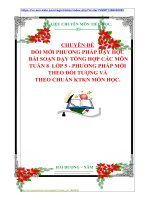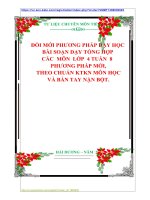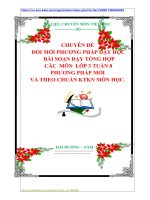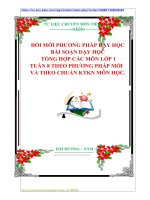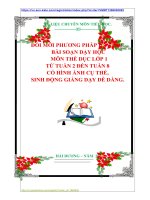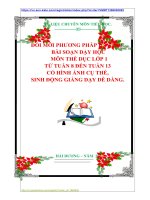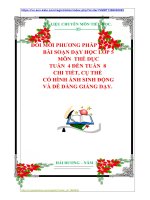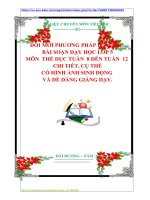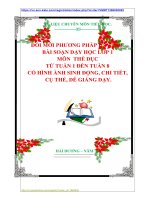Ta8 tuan 8 p22,23,24
Bạn đang xem bản rút gọn của tài liệu. Xem và tải ngay bản đầy đủ của tài liệu tại đây (144.02 KB, 11 trang )
<span class="text_page_counter">Trang 1</span><div class="page_container" data-page="1">
<b>Week 8 - Period 22</b>
<i>Date of planning: 23/10/2022</i>
<b>UNIT 3: PEOPLES OF VIET NAMLesson 7: Looking back and ProjectA. Objectives </b>
<b>1. Knowledge: By the end of the lesson, students will be able to recycle the language from</b>
the previous sections and consolidate and apply what they have learnt in Unit 3 by doing various activities and exercises.
<b>- Vocabulary: Vocabulary related to “Peoples of Viet Nam”.</b>
<i>- Grammar: Question words, articles: a/ an/ the.</i>
<b>2. Competence: Group work, individual work, pair work, linguistic competence,</b>
cooperative learning and communicative competence.
<b>3. Behavior: Students have serious attitude while working together. They know how to</b>
look back the knowledge they have learnt and master.
<b> . Teaching aids:</b>
<b>1. Teacher: Textbooks, teaching plan, teacher’s book…2. Students: Textbooks, notebooks…</b>
<i><b>a, Aim: To warm up the class and lead in the lesson.</b></i>
<i><b>b, Contents: Ss work individually to write how to make yellow sticky rice.c, Outcome: Ss can write a paragraph about how to make yellow sticky rice well.d, Organization:</b></i>
- T calls 2 students to come to the board and complete the words.
- Ss work individually.
- T checks and corrects as a class and leads ss to the new lesson.
<i><b>a, Aim: Help students review vocabularies and grammar they have learnt in Unit 3 and</b></i>
help Ss talk about the cultural groups of Viet Nam.
</div><span class="text_page_counter">Trang 2</span><div class="page_container" data-page="2"><i><b>b, Contents: </b></i>
<b>+ Ss work in pairs to complete the sentences with the words/ phrases from the box.</b>
+ Ss work individually to use the correct form of the words in brackets to finish the sentences.
+ Ss work in pairs to make questions for the underlined parts in the passage. + Ss work individually to find and correct the error.
+ Ss work individually to fill each gap with a, an or the to complete the passage. + Ss work in pairs to play a game.
<i><b>c, Outcome: Ss can review vocabularies and grammar they have studied in Unit 3 and do</b></i>
related exercises correctly. Also, Ss can talk about the cultural groups of Viet Nam well.
- Ss work individually to do the task.
- After that, T lets some Ss read the sentences aloud. Ss do it.
- T checks and corrects.
- T lets Ss read the passage aloud. Clarify any difficulties.
- Ss work in pairs to do the task. Then Ss give the answers.
- T checks and corrects.
<b>I. Vocabulary</b>
<b>1. Complete the sentences with thewords/ phrases from the box.</b>
<i>1.cultural groups 2. communal, activities 3. costumes, diverse 4. ethnic 5. unique</i>
<b>2. Use the correct form of the words inbrackets to finish the sentences.</b>
<i>1. cultural 2. peaceful 3. richness 4. diversity 5. traditional</i>
<b>II. Grammar</b>
<b>3. Make questions for the underlined parts in the passage.</b>
<i>1.What are these houses built on?2. Where is the entrance?</i>
<i>3. Which house is the largest, tallest andmost elaborate building in the village?4. What is it used for?</i>
<i>5. Who can sleep in this house?</i>
</div><span class="text_page_counter">Trang 3</span><div class="page_container" data-page="3">- T tells Ss to read the sentences carefully and try to find the error relating to articles in each sentence.
- Ss work individually to do the task. Then Ss give the answers.
- T checks and corrects.
- T asks Ss to complete this task individually. Ss do it. Then Ss give the answers.
T gives correction.
- T asks Ss to work in pairs. Let them recall what they have learnt about the cultural groups of Viet Nam.
- Ss take turns to ask each other questions about the topic. The person asking can look at the book. The first person to get five correct answers is the winner.
- If time allows, Ss switch partners and play again.
- T asks Ss to complete the self-assessment. Discuss as a class what difficulties remain and what areas Ss have mastered. Ss do it
<b>5. Fill each gap with a, an or the tocomplete the passage.</b>
<i>B: About 74 million. It’s the Viet or Kinh.A: Very good! Your turn.</i>
<i>B: OK. What is the population of the smallest group?</i>
<i>A: I think it’s the Odu group. B: Exactly!</i>
</div><span class="text_page_counter">Trang 4</span><div class="page_container" data-page="4">- T provide further practice on the weak areas of the class.
<b>3. Application (8’)</b>
<b>PROJECT: ETHNIC FASHION SHOW</b>
<i><b>a, Aim: To help Ss know how to do project about Ethnic fashion show.b, Contents: Ss work in groups to do project.</b></i>
<i><b>c, Outcome: Ss can know how to do project about Ethnic fashion show well.d, Organization:</b></i>
(1) T asks Ss to work in groups. T gives Ss about five minutes to discuss the question. Ss work in groups to discuss.
(2) T lets Ss work independently. T encourages Ss to use imagination and make their own costume designs (at home, or in class if possible, and with the materials available). T tells Ss to be creative. Ss do it.
<b>(3) In the next class, T helps Ss organize an exhibition of the costume</b>
designs they have made among the groups or class members. T lets them talk about their designs.
- Consolidates ss more about the main content of the lesson and asks ss to remember + Vocabulary relating to the topic “Peoples of Viet Nam”
+ Grammar: Questions + Articles
<b>* Homework: Asks Ss to:</b>
- Redo all exercises in notebook.
- Review all vocab, grammar and skills of Unit 1,2,3.
<i>Chuyên mônBGH ký duyệt ngày …. tháng 10 năm 2022</i>
<b>P. Hiệu trưởng</b>
<b>Nguyễn Thị Ngọc</b>
</div><span class="text_page_counter">Trang 5</span><div class="page_container" data-page="5"><i>Date of planning: 23/10/2022</i>
<b>A. Objectives </b>
<b>1. Knowledge: By the end of the lesson, students will be able to revise what they have</b>
studied and practiced in Unit 1, 2, 3. Revise what Ss have studied.
<i>- Pronunciation: clusters “/sk/, /sp/, /st/, /br/, pr/,/bl / and /cl/”</i>
<b>- Vocabulary relating to the topics in unit 1,2,3 </b>
- Grammar: Comparative forms of adjectives and adverbs of manner, verbs of liking, the
<i>article a, an, the.</i>
<b>2. Competence: Group work, individual work, pair work, linguistic competence,</b>
cooperative learning and communicative competence.
<b>3. Behavior: Students have serious attitude while working together. They can recall and</b>
master the knowledge systematically.
<b> . Teaching aids:</b>
<b>1. Teacher: Textbooks, teaching plan, teacher’s book…2. Students: Textbooks, notebooks…</b>
<b>+ Ss work individually to listen and repeat the words and phrases.</b>
+ Ss work individually to listen to the sentences and underline the words with /sk/, /sp/, / st/, /br/, /pr/, /bl/, and /cl/ in the following sentences. Then read the sentences aloud.
<i><b>c, Outcome: Ss can pronunciation about sk/, /sp/, /st/, /br/, /pr/, /bl/, /cl/ and do </b></i>
pronunciation exercises correctly.
<i><b>d, Organization: </b></i>
- T plays the recording and Ss repeat
individually. T plays the recording as many times as necessary. Pause and correct Ss’ pronunciation.
- T plays the recording two or more times, if
<b>1. Listen and repeat the following words and phrases.</b>
<b>2. Listen to the sentences and underlinethe words with /sk/, /sp/, /st/, /br/, /pr/, /bl/, and /cl/ in the following sentences. </b>
</div><span class="text_page_counter">Trang 6</span><div class="page_container" data-page="6">necessary. T helps Ss recognize all the words with /sk/, /sp/, /st/, /br/, /pr/, /bl/, and / cl/ then underline them as instructed.
- T asks Ss to read the sentences as a class, or individually. Ss do it.
- T checks pronunciation and intonation.
<i><b> (1).I used to climb trees when I was small.</b></i>
<i> (2). How can we improve our speaking skills?</i>
<i> (3). How annoying, the stadium has closed! (4). I want to buy a blue skirt for my mother. (5). “On a dark day, I saw a witch riding a broom in the sky…”</i>
<b>2. Vocabulary (12’)</b>
<i><b>a, Aims: Help Ss review the vocabularies they have learnt in unit 1,2,3.b, Contents: </b></i>
+ Ss work individually to organize these words and phrases into pairs of opposites and write them in the blanks.
+ Ss work individually to put a verb in the correct form in each gap to complete the sentences.
<i><b>c, Outcome: Ss can review the vocabularies they have learnt in unit 1,2,3 and do </b></i>
vocabulary exercises correctly.
<i><b>d, Organization:</b></i>
- T asks Ss to do the exercise individually and then share their answers with a partner.
- T asks some Ss to write their answers on the board. Ss do it.
- T corrects as a class.
<b>3. Organize these words and phrases into pairs of opposites and write them in the blanks.</b>
<i>peaceful – noisy; hard – easy </i>
<i>boring – exciting; forget – remember traditional – modern </i>
<i>country life – city life</i>
<i>love – hate; majority – minority</i>
<b>4. Put a verb in the correct form in each gap to complete the sentences.</b>
<i>1.like/ enjoy, listening, visiting2.forget 3. flying/ to fly</i>
<i>4. mind, to do/ doing 5. playing/ to play</i>
<b>3. Grammar (23’)</b>
<i><b>a, Aims: Help Ss review the grammar they have learnt in unit 1,2,3.b, Contents: </b></i>
</div><span class="text_page_counter">Trang 7</span><div class="page_container" data-page="7">+ Ss work individually to complete the sentences with the correct comparative form of adverbs from the adjectives in brackets.
+ Ss work individually to fill each blank with an article (a, an or the) to complete the
- T asks Ss to do this individually and compare their answers with a partner.
- T calls some Ss to go to the board to write their answers.
- Ss comment.
- T corrects as a class.
- T asks Ss to do the exercise individually. - T checks and call some Ss to read the whole passage.
- Ss do the task individually. Then they practice in pairs. After checking their answers, ask one or two pairs to act out the dialogues.
<b>5. Complete the sentences with the correct comparative form of adverbs from the adjectives in brackets.</b>
<i>1. later 2. more 3. more fluently 4. better 5. more simply 6. faster 7. more carefully</i>
<b>6. Fill each blank with an article (a, an or the) to complete the passage.</b>
<i>1. a 2. an 3. the 4. The 5. the 6. a</i>
<b>* Everyday English.</b>
<b>7. Match the sentences in A with those in B. Then practice with a friend.</b>
<i><b>Key: 1. b 2. e 3. a 4. c 5.d</b></i>
<b>3. Consolidation and guides for homework (2’)* Consolidation:</b>
- Consolidates ss more about the main content of the lesson and asks ss to remember
<b>* Homework: Asks Ss to:</b>
- Redo all exercises in notebook.
</div><span class="text_page_counter">Trang 8</span><div class="page_container" data-page="8"><b>1. Knowledge: By the end of the lesson, students will be able to improve their reading,</b>
speaking, listening and writing skills.
<b>- Vocabulary relating to the topics in unit 1,2,3.</b>
<b>2. Competence: Group work, individual work, pair work, linguistic competence,</b>
cooperative learning and communicative competence.
<b>3. Behavior: Students have serious attitude while working together. They can recall and</b>
master the knowledge systematically.
<b> . Teaching aids:</b>
<b>1. Teacher: Textbooks, teaching plan, teacher’s book…2. Students: Textbooks, notebooks…</b>
<i><b>a, Aims: To attract Ss’ attention to the lesson and to lead in the new lesson.b, Contents: Ss work individually to answer the questions.</b></i>
<i><b>c, Outcome: Ss can know about the topic they are going to study.d, Organization:</b></i>
<b>- T asks Ss to answer the following questions:</b>
<i>+ What do you know about a Museum? + What may be there in a museum?</i>
<i>+ Do you think museums provide you with a lotof knowledge?</i>
<i> (Do you think museums are useful?)</i>
- Introduces the new lesson.
<b>2. Reading (9’)</b>
<i><b>a, Aims: Help students review reading skill.b, Contents: </b></i>
+ Ss work individually to read the letter from Kim to her penpal, Jon. + Ss work individually to tick True or False.
+ Ss work in pairs to write the questions for the underlined phrases in the letter.
</div><span class="text_page_counter">Trang 9</span><div class="page_container" data-page="9"><i><b>c, Outcome: Ss can do reading exercise correctly.d, Organization:</b></i>
- T lets Ss read the letter once or twice.
- T clarifies anything they do not understand fully.
- Ss work individually to listen and take notes. - T has Ss read the letter once or twice then work on their own to tick true or false sentence. Ss work individually.
- T asks ss to read their answers and the explanations. Ss do it.
- T corrects.
- T has Ss do the exercises in pairs. Ss work in pairs to do the task.
- T corrects as a class.
<b>I. Reading</b>
<b>1. Read the following letter from Kim toher pen pal, Jon.</b>
<i><b>=> Vocabulary:</b></i>
<i><b>+ sculpture(n): nghệ thuật điêu khắc + preserve(v): bảo tồn</b></i>
<i><b>+ display (v): trưng bày </b></i>
<b>1a. Tick true or false</b>
<i>1.T 2. T 3. F 4. T 5. F</i>
<b>b. Write the questions for the underlinedphrases in the letter </b>
<i>1. Which museum does Kim love to visit onSaturday afternoons?</i>
<i>2. How many (clay and stone) objects areon display at the museum?</i>
<i>3. What can you learn in this museum/ DaNang Museum?</i>
<b>3. Speaking (8’)</b>
<i><b>a, Aims: Help students review speaking skill.</b></i>
<i><b>b, Contents: Ss work in pairs to talk about what their family members like to do in their free</b></i>
time.
<i><b>c, Outcome: Ss can do speaking exercise correctly.d, Organization:</b></i>
- T gets Ss to work in pairs and talk about what their family members like to do in their free time. Ss do it.
- T encourages Ss to talk as much as possible, using the verbs of liking they have learnt. Ss listen and do it.
- After some time, T may let Ss swap pairs and continue to talk.
<b>II. Speaking</b>
<b>2. Talk about what your family memberslike to do in their free time.</b>
</div><span class="text_page_counter">Trang 10</span><div class="page_container" data-page="10">- T goes round and gives assistance if necessary.
<b>4. Listening (8’)</b>
<i><b>a, Aims: Help students review listening skill.</b></i>
<i><b>b, Contents: Ss work individually to listen and choose the best answer.c, Outcome: Ss can do listening exercise correctly.</b></i>
<i><b>d, Organization:</b></i>
- T plays the recording once or twice. Ss work individually to listen and choose their answers.
- T plays the recording again for Ss to check their answers. Ss do it.
- T explains the new words or anything difficult if necessary. Ss listen and take notes in their notebooks.
<i><b>a, Aims: Help students writing about giving their opinions.b, Contents: Ss work individually to write about their opinions.c, Outcome: Ss can do writing exercise correctly.</b></i>
<i><b>d, Organization:</b></i>
- Before writing, have Ss brainstorm ideas about life in the countryside: advantages, disadvantages, what
they like and dislike, etc… Then explain the writing task. Also have them brainstorm words and phrases
they may need for their writing.
- Give Ss time to do the writing task. Then collect their papers to check out of class.
<b>4. Writing: Giving your opinion Sample writing:</b>
<i>In my opinion, life in the countryside hasmany good points. Firstly, country folk arefriendlier than city folk. Secondly, life isslower and simpler than in the city. Thefood is fresher and the air is cleaner.Finally, there are lots of traditionalactivities that we can do in the countrysidesuch as horse-riding, swimming in theriver or kite-flying. </i>
<i>For these reasons, I like country life.</i>
<b>3. Consolidation and guides for homework (2’)</b>
</div><span class="text_page_counter">Trang 11</span><div class="page_container" data-page="11"><b>* Consolidation:</b>
- Consolidates ss more about the main content of the lesson and asks ss to remember
<b>* Homework: Asks Ss to:</b>
- Redo all exercises in notebook.
- Revise carefully for the Mid term test.
</div>